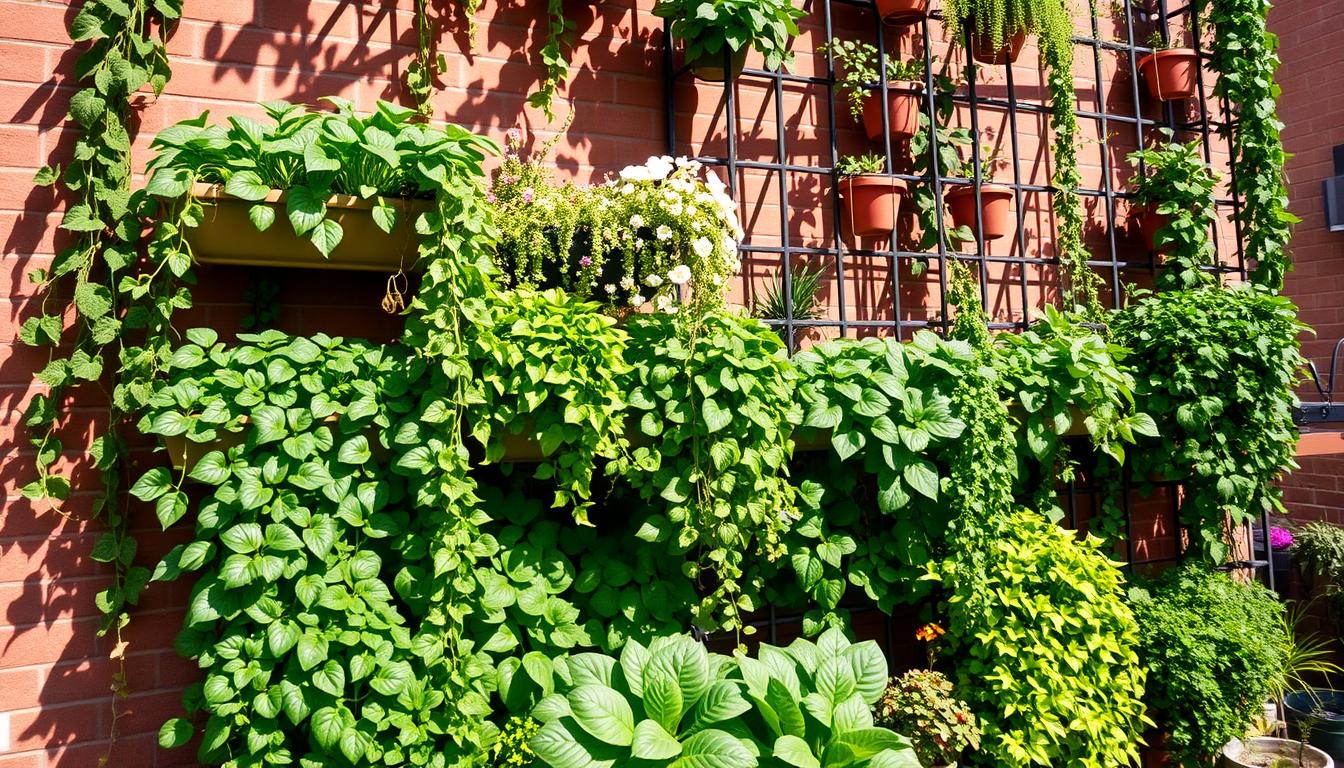Imagine turning your small balcony or tight urban spot into a green oasis. It’s full of fresh veggies and herbs. Vertical gardening is more than a trend. It’s a smart way to use every inch of space for growing.
It’s perfect for city folks with little outdoor room or suburban gardeners wanting to make the most of their yard. This method lets you grow more plants in a smaller area. It turns walls, fences, and corners into lively green spots.
With vertical gardening, you can grow tall tomatoes or small zucchini plants. It’s great for gardeners of all levels. You’ll be surprised at how much you can grow by thinking vertically.
Table of Contents
Understanding Vertical Gardening Fundamentals
Urban gardening has changed how city folks grow plants in tight spots. Vertical gardening is a big help for those wanting to turn small areas into green spaces.
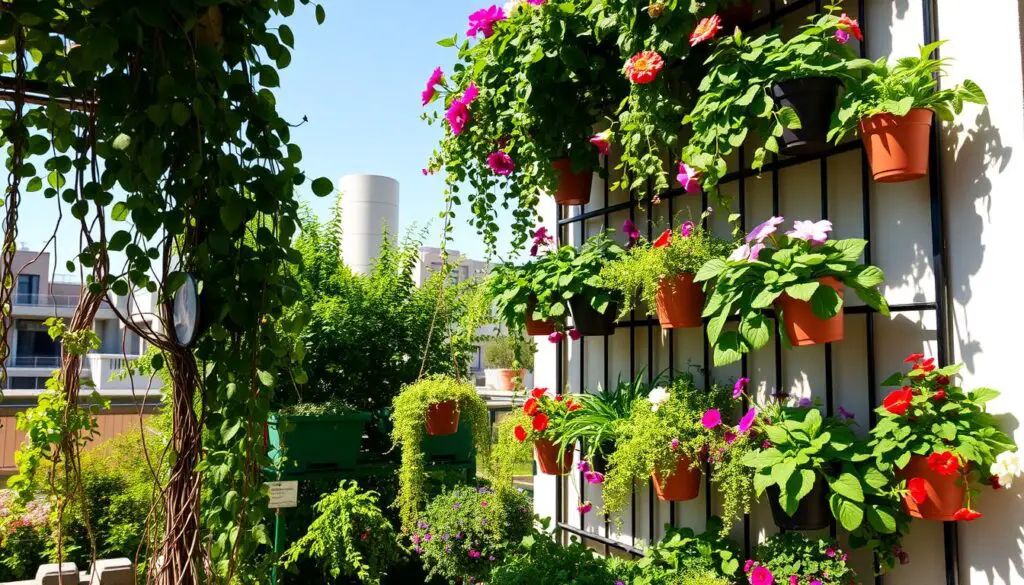
Indoor gardening fans are seeing the great benefits of vertical garden systems. These systems let you grow more by using space up instead of out.
What Makes Vertical Gardening Unique
Vertical gardening is different because it’s space-friendly. It has a few key points:
- Uses walls, fences, and trellises as supports
- Increases growing space in tight urban areas
- Makes it easier to reach plants, reducing strain
- Works well in high-rise apartments and small balconies
Key Components of a Vertical Garden System
Building a good vertical garden needs careful planning and certain parts:
- Strong support like wooden stakes or wire frames
- Deep containers, at least 2-3 feet deep
- Good irrigation systems
- Choosing the right plants
Space-Saving Benefits for Urban Gardeners
Vertical gardening boosts your growing area in cities. You can grow veggies, herbs, and plants in tiny spots like balconies or windowsills.
Vertical gardening lets you grow more with 99% less land than traditional farming.
If you live in the city or want to grow more, vertical gardening is a smart choice. It’s a way to grow fresh food and plants in small spaces.
Benefits of Growing Plants Vertically
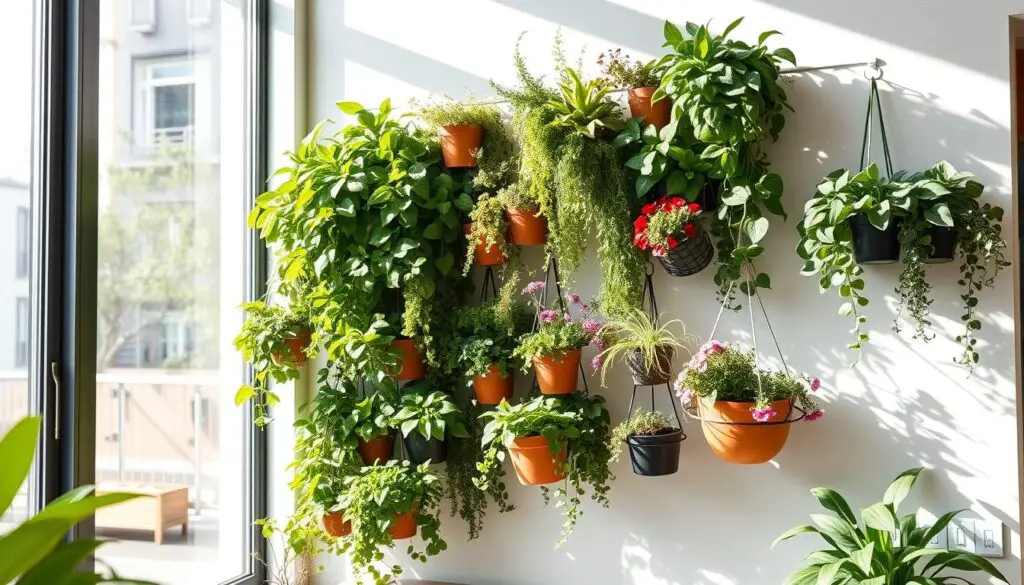
Vertical gardening changes your living space in amazing ways. It’s efficient and stylish. You can grow more in small areas. Imagine a bare wall becoming a lush, green space that looks great and is very useful.
Vertical gardening is more than just pretty. It has many benefits that make it a big change:
- It can grow up to 30% more than regular gardening
- It cuts down on soil diseases by about 50%
- Pests are less of a problem, by up to 40%
- You can get 2-3 times more food from each square foot
Green walls are good for the environment and your health. They clean the air, making it better inside and outside. By putting plants up high, you improve air flow. This cuts down on fungal diseases by up to 30%. Your garden becomes a living, breathing part of your space.
“Vertical gardening is not just a technique, it’s a sustainable lifestyle choice that reimagines how we interact with plants in limited spaces.”
Water use is another big plus. Vertical gardens use about 25% less water. This is because they drain better and lose water slower. They’re a green choice for city gardeners who want to save water and have a beautiful garden.
Whether you live in the city or the suburbs, vertical gardening is exciting. It lets you grow more in less space. Your green walls can make your home more vibrant, productive, and eco-friendly.
Essential Tools and Materials for Vertical Gardens
Creating a successful vertical garden needs the right tools and materials. Whether you’re setting up hydroponic systems or traditional garden towers, the right equipment makes all the difference.
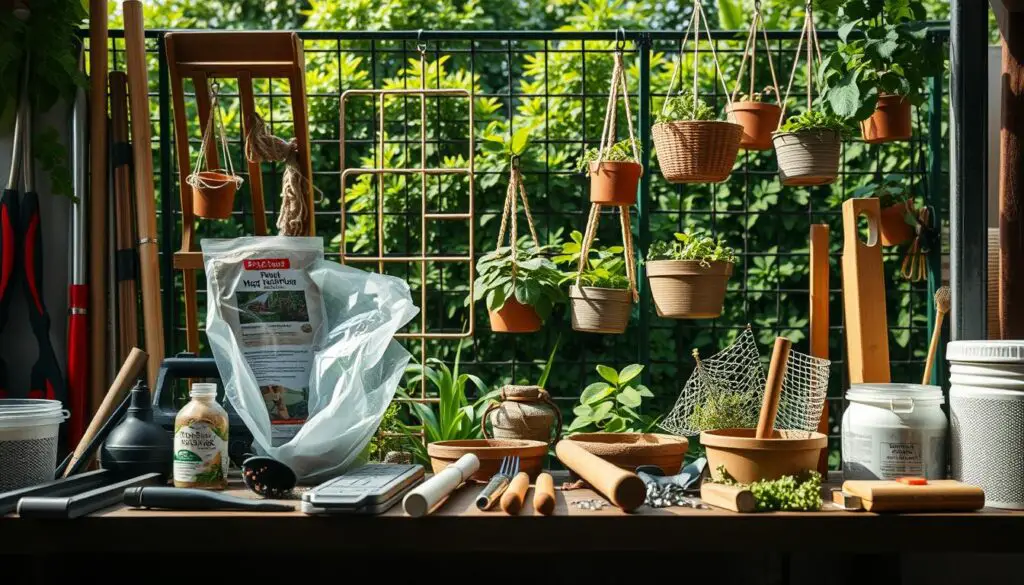
Start your vertical garden journey by picking the right support structures and containers. The right tools can turn your garden into a thriving oasis.
Support Structures and Trellises
Vertical gardens need strong support systems. Here are some options for building a solid garden framework:
- Metal arbors with adjustable configurations
- Wooden trellises with multiple attachment points
- Modular wall-mounted systems
- Pressure-treated pine rails for durability
Container Types and Growing Mediums
Choosing the right containers is key for a successful vertical garden. Different plants need different growing conditions.
| Container Type | Best For | Recommended Plants |
|---|---|---|
| Fabric Pocket Systems | Herbs and Small Vegetables | Basil, Mint, Cherry Tomatoes |
| Self-Watering Planters | Low-Maintenance Gardens | Succulents, Ferns |
| Vertical Hydroponic Systems | Efficient Space Growing | Lettuce, Spinach |
Irrigation Systems and Tools
Proper watering is vital for vertical gardens. Here are some irrigation strategies to consider:
- Drip irrigation systems
- Self-watering containers
- Moisture-retention growing mediums
- Regular monitoring tools
*”Success in vertical gardening is 90% preparation and 10% execution.”*
Your garden towers will flourish with the right tools and planning. Choose materials that fit your garden’s needs and your plants’ requirements.
Best Plants for Vertical Growing
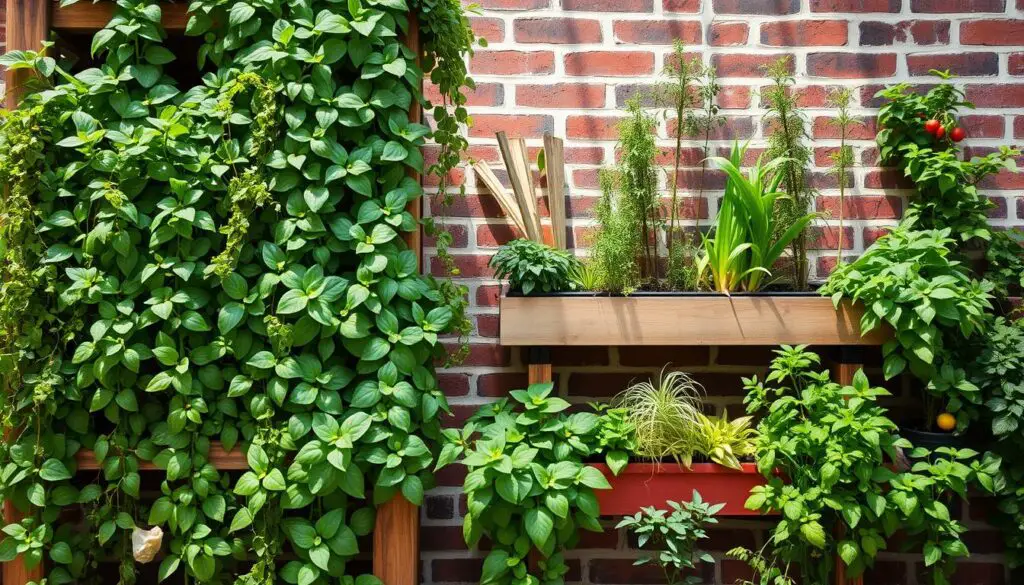
Vertical gardening lets you grow many plants in small spaces. It’s great for indoor gardens or outdoor areas. Choosing the right plants makes your vertical garden lush and green.
Some top plants for vertical gardens include:
- Vegetables:
- Tomatoes (indeterminate varieties can grow 6-12 feet tall)
- Pole beans (reaching 6-10 feet in height)
- Cucumbers
- Peas (maturing in as little as 55 days)
- Summer squash
- Climbing plants:
- Gourds (with vines up to 30 feet long)
- Melons (requiring strong support)
- Black-eyed Susan vine
- Cardinal climber
Think about each plant’s needs when planning your garden. Indeterminate tomatoes are perfect for tall trellises. Pole beans add beauty and food to your space.
Indoor gardeners can also grow great plants vertically. Good choices include:
- Herbs like basil and mint
- Trailing plants such as Devil’s Ivy
- Compact vegetable varieties
- Succulents and ferns
Tip: Check how much sunlight plants need. Most veggies need 6-8 hours of direct sun. For indoor gardens, pick a bright spot or use grow lights.
Remember, successful vertical gardening is about matching the right plants to your specific environment and support structures.
Space-Saving Design Strategies
Urban gardening has changed how we grow plants in small spaces. Even a tiny balcony or apartment can become a green oasis. Smart gardening techniques and vertical gardening make this possible.
Vertical gardens use up to 90% less floor area than traditional gardening. They’re great for city folks who want to grow their own food.
Utilizing Wall Space Effectively
Walls are a great spot for gardening. Here are ways to use them well:
- Install wall-mounted planters with modular designs
- Use hanging pocket gardens that attach directly to walls
- Create living walls with integrated irrigation systems
- Repurpose pallets or wooden frames as vertical garden structures
Maximizing Corner Areas
Corner spaces are often ignored but can be great for gardening. Use triangular shelving, spiral stands, or tower gardens to make them green and productive.
Balcony and Patio Solutions
Turn your outdoor areas into mini-gardens with smart design. Use trellises, tiered stands, and hanging baskets for herbs, veggies, and plants. This way, you save floor space.
Pro tip: Climbing plants like pole beans, peas, and cucumbers are perfect for vertical gardens. They grow up naturally.
With these strategies, you can make a vibrant urban garden in any small space. Creativity is key in urban gardening!
Vertical Gardening Systems and Methods
Vertical gardening has changed how we grow food in small spaces. With more people and cities growing, new ways like hydroponics and aeroponics are key.
Modern vertical gardening brings new ways to grow more:
- Soil-Based Systems: Uses old methods like trellises and wall planters
- Hydroponic Systems: Grows plants in water, not soil, with nutrient solutions
- Aeroponic Systems: Plants hang in air, getting misted with nutrients
Controlled Environment Agriculture (CEA) is vital in vertical gardening. It controls temperature, humidity, and light for better plant growth. Using vertical space, you can get amazing results:
- Up to 240 times more crops than regular farming
- 98% less water needed
- 99% less land used
Your vertical garden can grow many crops, from greens to climbing veggies. Plants like spinach, lettuce, and herbs do well in these systems.
Vertical gardening isn’t just a trend—it’s a sustainable solution for future food production.
Choosing hydroponics or aeroponics, vertical gardening lets you grow more food in less space. It’s great for city folks and garden lovers.
Soil and Nutrition Requirements
Creating the perfect growing environment is key for successful vertical gardening. Your plants’ health depends on the right soil mixture and nutrition. This is true whether you use traditional soil or advanced hydroponic systems.
Understanding soil composition is vital for thriving vertical gardens. The ideal soil pH range is between 6.0 and 7.0. This range supports optimal nutrient absorption for most plants.
Optimal Soil Mixtures
Different soil types need unique approaches in vertical gardening:
- Sandy soil needs 3-4 inches of organic matter to improve moisture retention
- Clay soil requires 3-4 inches of compost initially, with 1 inch added annually
- Silty soils benefit from 1 inch of organic matter yearly
Fertilization Schedules
Nutrition is key in vertical gardening. For hydroponic systems, a balanced nutrient solution replaces traditional fertilizers. In soil-based vertical gardens, fertilize every 2-4 weeks during the growing season.
| Soil Type | Organic Matter Recommendation | Fertilization Frequency |
|---|---|---|
| Sandy Soil | 3-4 inches | Every 3 weeks |
| Clay Soil | 3-4 inches initially | Every 4 weeks |
| Silty Soil | 1 inch annually | Every 2-3 weeks |
pH Balance Management
Maintaining the right pH is essential for nutrient availability. Slightly acidic soil between 6.0-6.5 pH works best for most plants in vertical gardening. Regular soil testing helps you track and adjust nutrient levels effectively.
Pro tip: Incorporate perlite or vermiculite to improve soil aeration and water retention in your vertical garden.
Maintenance and Care Tips
Keeping your vertical garden healthy needs regular care. Vertical gardens need a special maintenance plan. This is different from traditional gardens. You must understand the unique needs of plants in vertical spaces.
Watering is key in vertical gardening. These garden towers need more water because of their design. Roots can dry out fast, so a good watering schedule is important.
- Check soil moisture daily, specially in hot weather
- Use drip irrigation systems for even water distribution
- Water in the early morning or late evening to cut down on evaporation
- Make sure there’s proper drainage to avoid root rot
Nutrition is also vital for vertical garden health. Vertical gardens need more frequent fertilization. This supports plant growth in tight spaces.
| Maintenance Task | Frequency | Purpose |
|---|---|---|
| Fertilization | Monthly | Provide essential nutrients |
| Pest Inspection | Weekly | Prevent infestations |
| Pruning | As needed | Maintain plant shape and health |
Managing pests in vertical gardens is important. Organic pest control methods are best. They help keep your garden healthy without harsh chemicals. Regular checks can catch problems early.
With the right maintenance, your vertical garden will flourish. It will give you fresh produce, beautiful plants, and make the most of small spaces.
Common Challenges and Solutions
Urban and indoor gardening face unique challenges. Vertical gardens are great for small spaces but need careful care to keep plants healthy and the structure strong.
Gardeners must tackle problems early to protect their gardens. Knowing common issues helps avoid big problems and keeps the garden thriving.
Pest Management Strategies
Controlling pests is key in urban gardening. Aphids, spider mites, and mealybugs can harm plants a lot if not stopped.
- Check plants weekly for pests
- Use natural enemies like ladybugs
- Try organic pest control
- Keep plants far apart
Disease Prevention Techniques
Indoor gardens need careful disease management. Good care can lower the chance of plant sickness a lot.
| Prevention Method | Effectiveness |
|---|---|
| Regular pruning | Reduces disease spread by 60% |
| Proper air circulation | Prevents fungal growth |
| Sterilized tools | Minimizes pathogen transmission |
Structural Support Solutions
Vertical garden frames need regular checks to stay stable and last long. Regular inspections can stop structural problems.
- Look for rust or loose parts every quarter
- Choose materials that don’t rust
- Strengthen where plants are attached
- Replace old parts right away
Remember, keeping up with maintenance is essential for a thriving vertical garden in cities and homes.
Seasonal Considerations for Vertical Gardens
Your vertical gardening journey doesn’t pause with changing seasons. Green walls offer incredible flexibility for year-round plant cultivation. They allow you to adapt and thrive in diverse climate conditions. With strategic planning, your vertical garden can remain productive and vibrant throughout winter, spring, summer, and fall.
Seasonal adaptation requires understanding your specific environment and plant needs. Different vertical gardening approaches can help you maintain a healthy garden across temperature variations:
- Winter protection using greenhouse-style coverings
- Summer shade solutions for heat-sensitive plants
- Rotating crop selections based on seasonal requirements
- Implementing micro-climate management techniques
Climate resilience is key in vertical gardening. Research shows vertical gardens can save up to 80% of traditional gardening space while providing remarkable adaptability. By selecting plants with diverse temperature tolerances, you can create a dynamic green wall that flourishes year-round.
“Seasonal changes are not obstacles, but opportunities for creative gardening solutions.” – Urban Gardening Expert
The most successful vertical gardens integrate smart technology and thoughtful plant selection. Consider these seasonal strategies:
- Install adjustable irrigation systems
- Use temperature-regulating growing mediums
- Implement modular planting designs
- Monitor plant health through seasonal transitions
With careful planning, your vertical garden can become a resilient, ever-changing ecosystem. It defies traditional seasonal limitations.
Advanced Vertical Growing Techniques
Are you ready to level up your vertical gardening? Techniques like aeroponic and hydroponic systems are changing the game. They make growing plants in small spaces more efficient and productive.
Let’s dive into some top-notch vertical growing methods. They can change how you garden in the city:
- Aeroponic systems that use 95% less water than traditional farming
- Hydroponic systems that save up to 90% water compared to soil-based farming
- IoT-integrated vertical farming technologies
- Automated nutrient delivery systems
Your vertical garden can turn into a high-tech space with smart tech. Fertigation systems and advanced monitoring tools can boost plant growth by up to 25%. These tools help you adjust the environment for better plant growth.
| Technology | Water Savings | Efficiency Increase |
|---|---|---|
| Aeroponic Systems | 95% | 25% growth rate |
| Hydroponic Systems | 90% | 20% crop yield |
| IoT Vertical Farming | 30% energy reduction | 50% labor cost reduction |
Urban farmers can now use modular vertical farming systems. They fit in spaces as small as 2 square feet. By using these advanced methods, you’ll grow more and help make food production more sustainable and efficient.
Conclusion
Vertical gardening is a smart way to make small urban spaces green and productive. It uses wall and ceiling areas to create beautiful gardens. This is perfect for small homes or apartments, bringing nature inside and improving air quality.
Starting a vertical garden opens up many creative options. You can grow herbs like basil and thyme, or create living walls with succulents and ferns. It’s a great way to reduce stress and find joy in winter when outdoor gardening is hard.
Vertical gardening is more than a trend; it’s a sustainable way to grow food and improve health. It turns your home into a vibrant, healthy space. Begin with a small garden, try different plants, and watch it grow into a meaningful part of your life.
To succeed in vertical gardening, you need patience, creativity, and a desire to learn. With the right plants and a bit of imagination, your garden will flourish. It will add beauty, fresh food, and fresh air to your urban life.
For more gardening tips follow us on Pinterest
FAQ
Are there any drawbacks to using vertical gardens?
Yes, some potential disadvantages include:
Initial setup cost: Can be expensive depending on the system and materials used.
Watering issues: Uneven watering or drainage can affect plant health, especially in DIY systems.
Limited plant size: Large or deep-rooted plants may not thrive.
Maintenance: Plants at higher levels can be harder to access for pruning or harvesting.
Sunlight distribution: Lower tiers may get less light, affecting growth.
What cannot be grown in vertical farming?
Crops that typically don’t do well in vertical farming include:
Root vegetables: Carrots, beets, potatoes (need deep soil)
Tall or vining plants: Corn, most melons, and large fruiting trees
Large grain crops: Wheat, rice, barley (not space-efficient indoors)
What is the biggest downfall of vertical farming?
The most significant drawback is the high energy cost, especially for:
Artificial lighting (LEDs)
Climate control systems (temperature, humidity)
This can make large-scale operations less sustainable unless powered by renewable energy.
What vegetables grow best in vertical farming?
In vertical farming (often indoors with hydroponics or aeroponics), the best-performing crops include:
Lettuce
Spinach
Kale
Arugula
Basil
Pak choi (bok choy)
Microgreens
These crops are ideal due to:
Short growth cycles
Low height
Minimal nutrient demands
What is vertical gardening?
Vertical gardening is a method of growing plants upward using walls, trellises, shelves, or vertical structures instead of growing them horizontally in the ground. It’s ideal for small spaces and can be used both indoors and outdoors.
What plants are best for a vertical garden?
Ideal plants are compact, shallow-rooted, and grow well in containers:
Herbs: Basil, thyme, mint, parsley, oregano
Leafy greens: Lettuce, spinach, kale, arugula
Strawberries: Popular for tiered wall planters
Succulents: Low-maintenance and drought-tolerant
Ferns and pothos: Great for indoor vertical gardens
What is vertical gardening?
Vertical gardening is a way to grow plants on walls, trellises, or in containers. It’s great for small spaces, like apartments. It helps you grow more plants in less space, making your area look beautiful.
How much space do I need to start a vertical garden?
You don’t need much space to start a vertical garden. Even a tiny balcony or windowsill can be turned into a garden. Some systems need just a few square feet, perfect for city living.
What plants work best in vertical gardens?
Many plants do well in vertical gardens. Herbs like basil and mint, leafy greens, and small veggies like cherry tomatoes are good choices. Pick plants that grow small and need similar care.
Are vertical gardens difficult to maintain?
No, they’re not hard to care for. With the right setup and plant choices, your garden can be easy to maintain. Just check on it and prune now and then.
What types of vertical gardening systems exist?
There are many systems, like wall planters, garden towers, and living walls. Each has its own benefits. Choose based on your space and what you want to grow.
Can I grow food in a vertical garden?
Yes, you can grow food vertically. Many veggies, herbs, and fruits grow well this way. Lettuce, strawberries, and tomatoes are great choices.
How do I water a vertical garden?
Watering varies by system. Some use drip irrigation, while others need manual watering. Hydroponic systems often have built-in watering. Keep the soil moist but not too wet.
Are vertical gardens expensive to set up?
No, they can be affordable. You can start with DIY projects or buy more advanced systems. Prices vary from under to over 0.
Can vertical gardens work indoors?
Yes, they work well indoors. Place them near windows or use grow lights. They’re perfect for herbs and small plants, adding greenery to your home.
How do I prevent pest problems in a vertical garden?
Prevent pests by choosing the right plants and keeping them spaced right. Use organic pest control and check your plants often. Companion planting and natural repellents help keep pests away.
